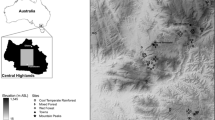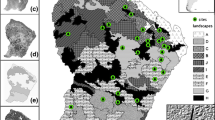Abstract
Landform has long been considered one of the primary controls on forest community structure; however, it is still unclear how the strength of such species–topography couplings varies in response to recurring disturbance events. We evaluated this question in the context of repeated prescribed fire applied to a forest landscape in eastern Kentucky, USA. The landscape encompassed different areas of varying treatment frequencies: no fire, less frequent fires (two times, 6-year interval), and frequent fires (four times, 1 or 2-year interval) over 8 years. For each of 32 plots (10 m × 40 m), species–landform data were collected seven times between 2002 and 2010. Results of canonical correspondence analysis showed generally decreasing importance of terrain attributes to the overall tree species composition, during and after the period of fire disturbance. Before fire, species composition showed high fractal dimensions and low Moran’s I, implying that the complex terrain of the area provided local, site-specific topographic controls on community structure. As fire was repeatedly applied, fractal dimensions decreased and Moran’s I increased, indicating that plots possessed increasingly similar vegetation characteristics regardless of site-specific terrain conditions; that is, local topography no longer acted as the primary driver of species composition because such a short-range spatial control became overwhelmed by a longer-range variation dictated by fire. Following a period of fire disturbance, forest modelers are recommended to avoid species distribution modeling heavily based on topographic parameters and to explicitly take into account potentially increasing spatial autocorrelation in species composition.



Similar content being viewed by others
References
Aksoy H, Kavvas ML (2005) A review of hillslope and watershed scale erosion and sediment transport models. Catena 64:247–271
Arseneault D (2001) Impact of fire behavior on postfire forest development in a homogeneous boreal landscape. Can J For Res 31:1367–1374
Arthur MA, Alexander HD, Dey DC, Schweitzer CJ, Loftis DL (2012) Refining the oak-fire hypothesis for management of oak-dominated forests of the eastern United States. J For 110:257–266
Austin MP, van Niel KP (2011) Improving species distribution models for climate change studies: variable selection and scale. J Biogeogr 38:1–8
Avers PE (1974) Soil survey of Menifee and Rowan Counties and northwestern Morgan County, Kentucky. Soil Conservation Service, Washington, DC
Baeza MJ, Valdecantos A, Alloza JA, Vallejo VR (2007) Human disturbance and environmental factors as drivers of long-term post-fire regeneration patterns in Mediterranean forests. J Veg Sci 18:243–252
Bahn V, McGill BJ (2007) Can niche-based distribution models outperform spatial interpolation? Glob Ecol Biogeogr 16:733–742
Battaglia LL, Foré SA, Sharitz RR (2000) Seedling emergence, survival and size in relation to light and water availability in two bottomland hardwood species. J Ecol 88:1041–1050
Bini LM, Diniz-Filho JAF, Rangel TFLVB, Akre TSB, Albaladejo RG, Albuquerque FS, Aparicio A, Araújo MB, Baselga A, Beck J, Bellocq MI, Böhning-Gaese K, Borges PAV, Castro-Parga I, Chey VK, Chown SL, De Marco P Jr, Dobkin DS, Ferrer-Castán D, Field R, Filloy J, Fleishman E, Gómez JF, Hortal J, Iverson JB, Kerr JT, Kissling WD, Kitching IJ, León-Cortés JL, Lobo JM, Montoya D, Morales-Castilla I, Moreno JC, Oberdorff T, Olalla-Tárraga MÁ, Pausas JG, Qian H, Rahbek C, Rodríguez MÁ, Rueda M, Ruggiero A, Sackmann P, Sanders NJ, Terribile LC, Vetaas OR, Hawkins BA (2009) Coefficient shifts in geographical ecology: an empirical evaluation of spatial and non-spatial regression. Ecography 32:193–204
Bivand R (2007) spdep. Spatial dependence: weighting schemes, statistics and models. R Package Version 0.4–7
Blöschl G, Merz R (2010) Landform-hydrology feedbacks. In: Otto JC, Dikau R (eds) Landform-structure, evolution, process control, vol 115., Lecture notes in Earth sciencesSpringer, Heidelberg, pp 117–126
Boerner REJ (2006) Unraveling the Gordian Knot: interactions among vegetation, topography, and soil properties in the central and southern Appalachians. J Torrey Bot Soc 133:321–361
Burrough PA (1983) Multiscale sources of spatial variation in soil. I. Application of fractal concepts to nested levels of soil variation. J Soil Sci 34:577–597
Certini G (2005) Effects of fire on properties of forest soils: a review. Oecologia 143:1–10
Collins RJ, Carson WP (2004) The effects of environment and life stage on Quercus abundance in the eastern deciduous forest, USA: are sapling densities most responsive to environmental gradients? For Ecol Manag 201:241–258
Culling WEH (1986) Highly erratic spatial variability of soil pH on Iping Common, west Sussex. Catena 13:81–98
Delcourt HR, Delcourt PA (1997) Pre-Columbian Native American use of fire on southern Appalachian landscapes. Conserv Biol 11:1010–1014
Delcourt PA, Delcourt HR (1998) The influence of prehistoric human-set fires on oak-chestnut forests in the southern Appalachians. Castanea 63:337–345
Dormann CF (2007) Effects of incorporating spatial autocorrelation into the analysis of species distribution data. Glob Ecol Biogeogr 16:129–138
Dray S, Legendre P, Peres-Neto PR (2006) Spatial modeling: a comprehensive framework for principal coordinate analysis of neighbor matrices (PCNM). Ecol Model 196:483–493
Foster S, Conner G (2001) Kentucky Climate Center. http://kyclim.wku.edu/climate/. Department of Geography, Western Kentucky University
Franklin J (1998) Predicting the distribution of shrub species in southern California from climate and terrain-derived variables. J Veg Sci 9:733–748
Franklin J (2009) Mapping species distributions. Cambridge University Press, Cambridge
Frelich LE (2002) Forest dynamics and disturbance regimes: studies from temperate evergreen–deciduous forests. Cambridge University Press, Cambridge
Heyerdahl EK, Brubaker LB, Agee JK (2001) Spatial controls of historical fire regimes: a multiscale example from the interior west, USA. Ecology 82:660–678
Huggett R, Cheeseman J (2002) Topography and the environment. Prentice Hall, London
Hutchinson TF, Long RP, Ford RD, Sutherland EK (2008) Fire history and the establishment of oaks and maples in second-growth forests. Can J For Res 38:1184–1198
Kang S, Doh S, Lee D, Lee D, Jin VL, Kimball JS (2003) Topographic and climatic controls on soil respiration in six temperate mixed-hardwood forest slopes, Korea. Glob Change Biol 9:1427–1437
Keeton WS, Franklin JF (2004) Fire-related landform associations of remnant old-growth trees in the southern Washington Cascade range. Can J For Res 34:2371–2381
Kupfer JA, Myers AT, McLane SE, Melton GN (2008) Patterns of forest damage in a southern Mississippi landscape caused by Hurricane Katrina. Ecosystems 11:45–60
Legendre P (1993) Spatial autocorrelation: trouble or new paradigm? Ecology 74:1659–1673
Lehmann A, Overton JM, Leathwick JR (2003) GRASP: generalized regression analysis and spatial prediction. Ecol Model 157:189–207
Lennon JJ (2000) Red-shifts and red herrings in geographical ecology. Ecography 23:101–113
Lepš J, Šmilauer P (2003) Multivariate analysis of ecological data using CANOCO. Cambridge University Press, Cambridge
Loucks E, Arthur MA, Lyons JE, Loftis DL (2008) Characterization of fuel before and after a single prescribed fire in an Appalachian hardwood forest. South J Appl For 32:80–88
McEwan RW, Hutchinson TF, Ford TD, McCarthy BC (2007) An experimental evaluation of fire history reconstruction using dendrochronology in white oak (Quercus alba). Can J For Res 37:806–816
McKenzie D, Miller C, Falk DA (2011) The landscape ecology of fire. Springer, New York
McNab WH (1993) A topographic index to quantify the effect of mesoscale landform on site productivity. Can J For Res 23:1100–1107
Miller J (2010) Species distribution modeling. Geogr Compass 4:490–509
Miller J, Franklin J, Aspinall R (2007) Incorporating spatial dependence in predictive vegetation models. Ecol Model 202:225–242
Moore ID, Grayson RB, Ladson AR (1991) Digital terrain modelling: a review of hydrological, geomorphological, and biological applications. Hydrol Process 5:3–30
Morgan P, Hardy CC, Swetnam TW, Rollins MG, Long DG (2001) Mapping fire regimes across time and space: understanding coarse and fine-scale fire patterns. Int J Wildland Fire 10:329–342
Palmer MW (1988) Fractal geometry: a tool for describing spatial patterns of plant communities. Plant Ecol 75:91–102
Palmer MW (1993) Putting things in even better order: the advantages of canonical correspondence analysis. Ecology 74:2215–2230
Parsons M, McLoughlin CA, Kotschy KA, Rogers KH, Rountree MW (2005) The effects of extreme floods on the biophysical heterogeneity of river landscapes. Front Ecol Environ 3:487–494
Phillips JD (1985) Measuring complexity of environmental gradients. Plant Ecol 64:95–102
Schabenberger O, Gotway CA (2005) Statistical methods for spatial data analysis. Chapman and Hall, Boca Raton
Schoennagel T, Sherriff RL, Veblen TT (2011) Fire history and tree recruitment in the Colorado Front Range upper montane zone: implications for forest restoration. Ecol Appl 21:2210–2222
Stohlgren TJ, Bachand RR, Onami Y, Binkley D (1998) Species–environment relationships and vegetation patterns: effects of spatial scale and tree life-stage. Plant Ecol 135:215–228
Sutherland EK (1997) History of fire in a southern Ohio second-growth mixed-oak forest. In: Pallardy SG, Cecich RA, Garrett HE, Johnson PS (eds) Proceedings of the 11th central hardwood forest conference, pp 172–183
Takaoka S, Sasa K (1996) Landform effects on fire behavior and post-fire regeneration in the mixed forests of northern Japan. Ecol Res 11:339–349
ter Braak CJF (1995) Ordination. In: Jongman RHG, ter Braak CJF, van Tongeren OFR (eds) Data analysis in community and landscape ecology. Cambridge University Press, Cambridge, pp 91–173
Tsujino R, Yumoto T (2009) Topography-specific seed dispersal by Japanese macaques in a lowland forest on Yakushima Island, Japan. J Anim Ecol 78:119–125
Turner MG (2010) Disturbance and landscape dynamics in a changing world. Ecology 91:2833–2849
Václavík T, Kupfer JA, Meentemeyer RK (2012) Accounting for multi-scale spatial autocorrelation improves performance of invasive species distribution modeling (iSDM). J Biogeogr 39:42–55
von Ende CN (2001) Repeated-measures analysis. In: Scheiner SM, Gurevitch J (eds) Design and analysis of ecological experiments. Oxford University Press, Oxford, pp 134–157
Wilson JP, Gallant JC (2000) Terrain analysis: principles and application. Wiley, New York
Zou CB, Barron-Gafford GA, Breshears DD (2007) Effects of topography and woody plant canopy cover on near-ground solar radiation: relevant energy inputs for ecohydrology and hydropedology. Geophys Res Lett 34:L24S21. doi:10.1029/2007GL031484
Acknowledgments
This study (#14-09-006) is connected with a project of the Kentucky Agricultural Experiment Station. The research was partially funded by the USDA-USDI Joint Fire Science Program (01-3-3-14, 04-2-1-06) through cooperative research agreements with the Southern Research Station, McIntire-Stennis Funds administered by the Kentucky Agricultural Experiment Station, and a Challenge Cost-Share Agreement with the Daniel Boone National Forest. We thank our USDA Forest Service collaborators, including E.J. Bunzendahl, Jeff Lewis, and David Loftis, among others. This study could not have been conducted without the field and laboratory support of many people, especially Gretchen Sovkoplas, Autumn Foushee, Jessi Lyons, Heather Alexander, Elizabeth Loucks, Beth Blankenship, Stephanie Green, and many others. Jonathan Phillips and Soohyun Jung provided constructive comments on an earlier version of this paper.
Author information
Authors and Affiliations
Corresponding author
Electronic supplementary material
Below is the link to the electronic supplementary material.
About this article
Cite this article
Kim, D., Arthur, M.A. Changes in community structure and species–landform relationship after repeated fire disturbance in an oak-dominated temperate forest. Ecol Res 29, 661–671 (2014). https://doi.org/10.1007/s11284-014-1157-y
Received:
Accepted:
Published:
Issue Date:
DOI: https://doi.org/10.1007/s11284-014-1157-y




